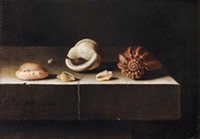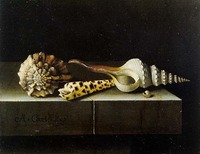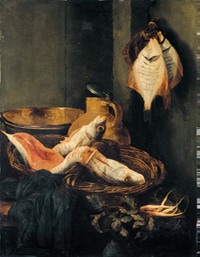Takahashi Shells 1878

In 1867 a collection of Dutch oil- and waterpaintings was brought to Japan by Uchida Tsunejiro probably on board of the Japanese war vessel Kaiyo Maru. Somehow the painter Takahashi Yuichi had the opportunity the study the collection of paintings. I do not know in which year he saw the paintings but it is not unlikely it must have been somewhere around 1870. During that period Takahashi was still developing his Western style painting skill and it is an intriguing question to which extent the Dutch paintings influenced Takahashi's development as an oilpainter. Untill now I could not find any sources giving information about the Dutch paintings. So there is some room for the following speculation.
Striking in the oeuvre of Takahashi are the still lifes of fish, tofu and shells (see above) he made in the seventies of the nineteenth century.
Still lifes of this kind were untill then quite exceptional in Japanese painting.
Still lifes are very suitable to practice the technical skills. Painters like van Gogh considered the still life as an excellent way to exercise with texture, brush technique and style. In general painters specialized in still lifes consider the accomplishment of the highest degree of realism as the ultimate goal.
The high degree of realism of Western art was an eyeopener for the Japanese. It is obvious that Takahashi used the still lifes as technical exercises, but it is also likely that he, as a pioneer, wanted to demonstrate the high degree of realism that could be accomplished with the proper use of oilpaint. The objects he painted were very ordinary and close to the daily life of the common Japanese.
The food still life was very common and popular in the Netherlands during the end of the 17th century. Adriaen Coorte (1665-1707) painted several still lifes with shells (see left). Abraham van Beijeren (1620-1690) is wellknown as a painter of fish still lifes (see left ). If you compare the Japanese and Dutch still lifes, it is clear that Takahashi was not yet able to match the high degree of perfection of Coorte. But there are similarities in terms of composition. That is also the case with Takahashi's salmon and elements of the fishstill life of van Beyeren, like the hanging fishes, the almost vertical position of the fish in the basket and the red meat of the cut fish on the foreground.


